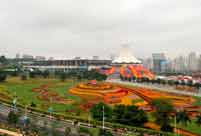 China's new-type guided missile frigate 'Bengbu' in live fire training
China's new-type guided missile frigate 'Bengbu' in live fire training
 China’s weekly story (2013.8.10 - 8.23)
China’s weekly story (2013.8.10 - 8.23)
 Flight team performs first show abroad
Flight team performs first show abroad
 With parents bedridden, 12-year-old boy becomes pillar of the family
With parents bedridden, 12-year-old boy becomes pillar of the family
 Top 10 private Chinese enterprises 2013
Top 10 private Chinese enterprises 2013
 The most gorgeous Chinese women in the eyes of foreigners
The most gorgeous Chinese women in the eyes of foreigners
China’s good neighbor policy towards ASEAN is not a measure of expediency, but a long-term strategic choice.
2013 marks the 10th anniversary of the establishment of the strategic partnership between China and the Association of Southeast Asian Nations (ASEAN) as well as the 10th anniversary of the China-ASEAN Expo and the China-ASEAN Business and Investment Summit. Through more than 40 bilateral cooperation mechanisms and platforms, China-ASEAN comprehensive cooperation is developing in multiple directions.
China and ASEAN are capable of going beyond a “Golden Decade“ of cooperation. A “Diamond Decade” ought to be the target.
At present Asia is one of the most dynamic areas in world economic activity. China and ASEAN constitute the most active free trade area in Asia. China has been ASEAN's largest trade partner for 4 consecutive years, while ASEAN is China's third largest trade partner, fourth largest export destination, and second largest source of imports. The close interaction between China and ASEAN not only benefits our peoples, but also provides dynamic momentum for Asian and World economic development.
Development strengthens cooperation, while cooperation promotes development. China and ASEAN are natural partners, as both parties are at a similar stage of development – engaged in rapid progress towards urbanization and industrialization. Thus both parties face the common task of developing their economies and improving living standards for the general population. Enhancing China-ASEAN economic cooperation will definitely act as a powerful force.
Through cooperation, China and ASEAN can achieve mutual benefit. In terms of its diplomatic strategy, China has always made a priority of developing ties with ASEAN countries. ASEAN also places a high value on the great potential and vast market of China’s economy. Against the backdrop of gloomy economic prospects in America and Europe, China and ASEAN have experienced the benefits of cooperation. Both parties are well aware of the fact that only by enhancing cooperation can we strengthen ourselves and obtain win-win results.
China and ASEAN have different strengths in business, natural resources, productive capacity and industrial structure. Therefore we are highly complementary in all these aspects. However we also compete in some low-end products. How to exploit our respective advantages and discover greater complementary potential is the key to further strengthening China-ASEAN cooperation.
Faced with the complexity of the world economic recovery, emerging markets and developing countries are jointly confronted by new challenges. As is the case with all developing countries, China and ASEAN can no longer rely on exports to developed countries as an engine of growth. We need to adjust our economic policies, promoting economic recovery by increasing investment in infrastructure and boosting domestic demand.
China will strive to expand bilateral trade to 1 trillion U.S. dollars by 2020 and increase bilateral investment by 150 billion dollars over the next eight years. Growing domestic demand in China will offer great market opportunities for ASEAN products. As some low-end industries move from China to ASEAN, demand for China’s middle-end products will grow in the ASEAN countries, and new industrial chains will be formed. Through improved standards of living and greater capacity for consumption, both sides are forming a new complementarity.
The upgraded version of the China-ASEAN Free Trade Area (CAFTA) that China and ASEAN are striving to build is an attempt to increase bilateral complementarity. This ungraded version will renew and expand the content of CAFTA - reducing customs duties, cutting non-tariff measures, facilitating trade and investment, and building Asian financial platforms, as well as promoting cooperation across sectors such as finance, environmental protection, and maritime issues.
China’s good neighbor policy is not a measure of expediency but a long-term strategic choice. China will continue to support the construction of the ASEAN Community and back the leading role of ASEAN in East Asia cooperation. Both parties are committed to friendly negotiations to solve disputes, building mutual trust, and avoiding any negative consequences of bilateral cooperation. The success of the China-ASEAN model demonstrates the great potential for cooperation among developing countries.
Edited and Translated by Yao Chun, People's Daily Online
Read the Chinese version: 创造合作的“钻石十年”, source: People's Daily
 Mexican president delivers first State of Nation address
Mexican president delivers first State of Nation address Highlights of MAKS 2013 Int'l Aviation and Space Show
Highlights of MAKS 2013 Int'l Aviation and Space Show  10th China-ASEAN Expo opens in Nanning
10th China-ASEAN Expo opens in Nanning Baby born to save his sister - the story of a savior sibling
Baby born to save his sister - the story of a savior sibling Lady of mystery: Female SWAT team in prison disclosed
Lady of mystery: Female SWAT team in prison disclosed  Single mother, baby live in KFC restaurant for months
Single mother, baby live in KFC restaurant for months Top 10 naked hotels in the world
Top 10 naked hotels in the world The most gorgeous Chinese women in the eyes of foreigners
The most gorgeous Chinese women in the eyes of foreigners A collection of bizarre rooftop buildings around China
A collection of bizarre rooftop buildings around China Putin intimate contacts with marine animals
Putin intimate contacts with marine animals China's frigate 'Bengbu'in fire training
China's frigate 'Bengbu'in fire training Fresh students 'forced' to register in university independently
Fresh students 'forced' to register in university independently 2013 Taiwan Int'l Tourism Expo kicks off in Taipei
2013 Taiwan Int'l Tourism Expo kicks off in Taipei Photo story: Take a gap year
Photo story: Take a gap year Nokia's Global Headquarters: visiting a declining empire
Nokia's Global Headquarters: visiting a declining empireDay|Week|Month